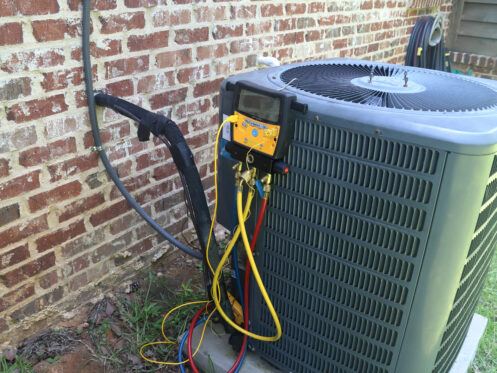Pollen and other airborne allergens make spring an especially bad time for millions of individuals throughout the globe who already suffer from allergies. A great strategy to deal with spring allergies is to become an expert user of the HVAC system. When used strategically, the HVAC system can reduce allergens in the home, resulting in fewer allergy symptoms.
Common Causes of Indoor Allergens in Gurnee
In Gurnee, IL, springtime typically brings a mix of weather patterns characterized by fluctuating temperatures, increased precipitation, and blooming vegetation. Average temperatures range from 40 to 60 Fahrenheit with occasional warmer days reaching the 70s and 80s. Precipitation is common, with frequent rain showers and occasional thunderstorms. As temperatures rise and plants begin to bloom, pollen levels increase, triggering allergic reactions such as sneezing, congestion, itchy eyes, and respiratory discomfort. The combination of pollen and moisture from rain showers can also lead to mold growth, further aggravating allergy symptoms for susceptible individuals.
Using a High-Efficiency Air Filter
In Gurnee, where spring weather can be unpredictable, residents may find themselves alternating between using the furnace one day and the cooling system the next. This constant switching between heating and cooling modes underscores the importance of keeping the filters in both systems clean at all times. Filters in HVAC systems are inefficient and reduce airflow when they become clogged with allergens, dust, pollen, and other debris. The outcome is an increase in indoor airborne allergens due to ineffective filtering.
To combat allergens effectively, homeowners should use high-efficiency particulate air (HEPA) filters, which are particularly effective at trapping microscopic allergens, including pollen, pet dander, mold spores, and dust mites. For the best performance and air quality inside the home, you need to check the filters once a month and change them as needed.
Keeping Humidity Levels at the Right Level
Homeowners in Gurnee tend to experience fluctuations in humidity levels during the spring. High humidity can create a conducive environment for mold growth and dust mites, both of which are common allergens. Low humidity can lead to dry air, which can exacerbate respiratory irritation and allergy symptoms as well. Several other factors can affect humidity levels in the home, including indoor heating and cooling systems and ventilation. For example, running a furnace can reduce indoor humidity levels, especially if the home lacks adequate ventilation and moisture control measures.
One of the most effective ways to control indoor humidity levels is to use whole-home humidifiers and dehumidifiers. These systems integrate directly with the home’s HVAC system. During the spring, a whole-home dehumidifier can help reduce excess moisture, while a humidifier can add moisture to the air if it becomes too dry. Whole-home humidifiers and dehumidifiers come in various types, including bypass, fan-powered, and steam humidifiers, as well as refrigerative, absorbent, and desiccant dehumidifiers. Homeowners should consider factors like the size of their home, humidity levels, and budget when choosing the best type for combating allergies. Consulting with HVAC professionals can provide valuable guidance in making the right selection.
Preventing Allergen Infiltrations With Sealed Ductwork
Leaky ductwork can manifest in various ways. Homeowners should watch out for uneven heating or cooling, increased energy bills, excessive dust buildup, and noticeable whistling or rattling noises coming from the ducts. Leaky ductwork makes allergies worse, particularly in the spring, by allowing outdoor allergens such as pollen, mold spores, and dust to infiltrate the home’s air supply. Common causes of leaky ductwork include poor installation, inadequate insulation, damage from pests or rodents, and regular wear and tear.
Regularly sealing and cleaning ductwork can effectively address these issues by preventing air leakage and removing accumulated dust and debris. Ideally, homeowners should get their ductwork cleaned every one to two years, considering factors like usage and environmental conditions. Seal ductwork as needed, using annual inspections to promptly address any leaks or damage.
Using a Programmable Thermostat to Reduce Allergens
Programmable thermostats allow homeowners to set and maintain consistent indoor temperatures, reducing fluctuations that can exacerbate allergy symptoms. Many versions come with filter reminder features that alert homeowners when it’s time to change the HVAC filter. This ensures that the air circulating in the home is free from allergens and pollutants.
Some programmable thermostats have humidity control settings that help maintain optimal indoor humidity levels. These thermostats work exceptionally well at preventing mold and mildew growth, which are common allergens. Certain models integrate with air purification systems, such as HEPA filters or UV-C lights, to further improve indoor air quality and reduce allergens.
Programmable thermostats with zoning capabilities allow homeowners to control temperatures in different areas of the home independently. This prevents overcooling or overheating in certain rooms, reducing the spread of allergens. All programmable thermostats come with smart scheduling features, allowing homeowners to create customized heating and cooling schedules based on their daily routines. Smart scheduling prevents unnecessary HVAC usage and reduces energy costs without compromising indoor comfort.
Many programmable thermostats offer remote access via smartphone apps, allowing homeowners to adjust temperature settings from anywhere. This feature enables quick adjustments to indoor conditions, especially during high pollen or allergy seasons. Some advanced versions come equipped with air quality sensors that monitor indoor air quality in real time. This feature provides insights into allergen levels and prompts adjustments to HVAC settings accordingly. Programmable thermostats with ventilation control capabilities can regulate the amount of fresh outdoor air brought into the home. By controlling ventilation, these thermostats help minimize the entry of allergens while maintaining indoor air freshness.
Scheduling Regular HVAC Maintenance
One of the most effective ways to combat spring allergies with an HVAC system is to schedule expert maintenance visits once a year. Cleaning HVAC coils removes mold, bacteria, and other contaminants that can contribute to poor indoor air quality and aggravate allergies. Cleaning the condensate drain prevents water accumulation and mold growth, reducing allergens in the air and preventing respiratory issues.
During maintenance checks, HVAC technicians also inspect for mold growth in and around the system, addressing any issues promptly to prevent allergen exposure. Inspecting and cleaning air vents ensures proper airflow and reduces the buildup of allergens, dust, and debris in the home. Calibrating the HVAC system ensures it operates efficiently, maintaining consistent temperatures and optimal humidity levels to minimize allergen proliferation.
Keeping Windows Closed
Opening windows is a great way to let stale air out of the home and fresh air in. However, leaving windows open during the spring can invite outdoor allergens like pollen, mold spores, and dust into the home. These allergens can infiltrate the indoor environment and circulate through the HVAC system, triggering allergic reactions. Open windows also disrupt the home’s moisture balance, promoting mold growth and worsening allergy symptoms. If you decide to open the windows, make sure to do it during a time when pollen levels are low and only leave them open for a few minutes.
Modern Heating and Plumbing wants to help make your home more comfortable and energy-efficient. We work on regular HVAC systems, heat pumps, water heaters, combi boilers, ductwork, and more. Give us a call today to learn more about combating spring allergies with your HVAC system.


